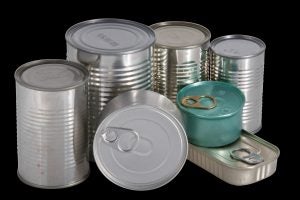Tom Neltner, Chemicals Policy Director and Maricel Maffini, consultant
The Food and Drug Administration (FDA) took an important step last week to protect food from PFAS contamination from plastic packaging. On August 5, the agency sent a letter to manufacturers, distributors, and users of fluorinated polyethylene food contact articles reminding them that these articles must be made under specific conditions to comply with existing regulation or otherwise the food contact articles “are not lawful.” Therefore, the food that contacted them should not be permitted for sale. The agency gave three examples of manufacturing processes that do not comply with the regulation. We flagged concerns with fluorinated plastic packaging in a July blog and applaud the agency for this action.
This significant first step needs to be followed:
- Investigate the companies that provided fluorinated plastic packaging for food and cosmetic uses to determine whether their products complied with the law. If not, then alert food manufacturers and retailers so they can recall the adulterated food and cosmetics.
- Reassess whether the process FDA approved in 1983 for fluorinating polyethylene generates PFAS and whether it should still be considered safe.
Investigate companies that provided fluorinated plastic packaging
In the letter, FDA’s Office of Food Additive Safety (OFAS) states that “available information indicates that some manufacturers of fluorinated polyethylene produce articles via alternative manufacturing methods from that stipulated in FDA’s regulation.” It identified three specific examples and says that “these alternative processes for fluorination of polyethylene are not compliant with 21 CFR § 177.1615, and are not lawful for use in food contact articles.” The three examples of unlawful manufacturing processes are:
- “Fluorination of polyethylene for non-food uses may occur during the fabrication or molding of the container.”
- “Use of fluorine gas in combination with other inert diluents such as carbon dioxide, helium, or argon.”
- Incorporation of oxygen into the fluorinating mixture to modify the properties of the final container.
A market search shows several brands that have in-mold fluorination of high-density polyethylene (HDPE), (here and here) and another that may use oxygen or other gases in combination with fluorine.
With the letter public, FDA’s Office of Regulatory Affairs (ORA), which handles field inspections and sampling for the agency, should ensure compliance by food manufacturers all along the supply chain. Where it finds a violation, it would manage the recall of the adulterated food.
Reassess whether the allowed use generates PFAS and should still be considered safe
About a week before FDA sent out the letter, the agency responded to our May 2021 FOIA request for the documentation that resulted in its 1983 approval of fluorinated polyethylene packaging at 21 CFR § 177.1615. The approval came in response to a 1979 food additive petition by Union Carbide.
As with most of FDA’s FOIA responses, the 233-page document has extensive redactions of health and safety information. However, two things come through clearly:
- Nitrogen and fluorine only: In its petition and communications with FDA, Union Carbide was inconsistent when it explained whether nitrogen was only an example of an acceptable inert gas. FDA scientists demanded clarity and the company agreed that only nitrogen would be allowed. In its recent letter, FDA reminds companies that only this condition is approved.
- Fluorinated organics: The petition included studies of the chemicals that migrated into a simulated food such as water or alcohol. The study evaluated the residue that remained after the food simulant was evaporated off. Union Carbide maintained that fluorine in the residue was almost entirely ionic fluorine – the kind added to toothpaste – and showed that the exposure was within tolerated levels. FDA scientists kept pushing back explaining that there was evidence the residue contained substances with a carbon-fluorine bond – a indicator of what we now refer to as PFAS. FDA finally relented, stating that “our general conclusion is that low molecular weight fluorocarbon-oxygen compounds should not be present in significant quantities.” (see page 195 of FOIA response).
We now know that levels of PFAS that were considered insignificant by FDA in the 1980s pose significant risks as evidenced by some of the agency’s recent actions. For those reasons, we reaffirm our call in our July 2021 blog and in the June 2021 citizens petition submitted by 11 organizations to FDA to reassess the safety of PFAS uses, including fluorinated polyethylene.
As part of that reassessment, FDA needs to revisit the concerns raised by the agency scientists in 1983 in light of the risks posed by PFAS. Specifically:
- Nitrogen: In its August 5 letter, FDA states that a form of PFAS known as perfluoroalkyl carboxylic acids “can form when the fluorination of HDPE occurs in the presence of oxygen or water, but not in the presence of nitrogen.” However, the agency does not acknowledge that commercially available nitrogen contains contaminants like oxygen. Food-grade nitrogen can have as much as 10,000 parts per million (ppm) of oxygen and 55 ppm of water. These levels could well be sufficient to generate significant amounts of PFAS.
- PFAS leaching into food: Since the amount of PFAS in food considered “significant” is dramatically lower than in 1983 when FDA made its decision, the agency needs to evaluate whether it is practical – even with the purest nitrogen – to fluorinate plastic without making PFAS.
If the agency determines that the fluorine gas treatment process creates any PFAS, the law explicitly requires that FDA evaluate safety after taking into account the cumulative effects of related substances in the diet that have related health impacts. As with virtually all of its decisions, the agency failed to do that for its 1983 approval. Given the pervasive presence of PFAS in the environment and the additional PFAS FDA authorized for use in food packaging, this type of review is even more important.
Conclusion
In summary, FDA’s August 5, 2021 letter is an important step in the effort to protect consumers from PFAS in food. Now the agency needs to investigate the companies that provided fluorinated plastic packaging for food and cosmetic uses to determine whether the products complied with the law and take action. It must also reassess the safety of the packaging even if it complies with the specific conditions in its 1983 approval.











